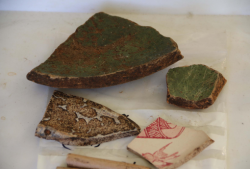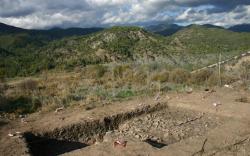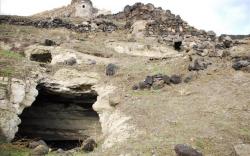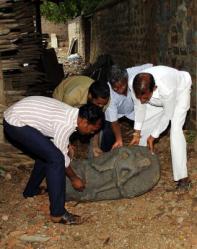INSTITUT SUPERIEUR D'ANTHROPOLOGIE
INSTITUTE OF ANTHROPOLOGY
ONLINE COURSES / COURS A DISTANCE
SPRING TERM : APRIL 2015
REGISTER NOW
IRAN –  Sarbisheh - The second phase of archeological excavations in Sarbisheh, South Khorasan, has unearthed a medieval temporary settlement along with some pieces of ancient pottery.Head of Sarbisheh archaeology division Mohammad Farjami confirmed this, adding that the initial findings comprised several pieces of pottery, some metal slags and pieces from a grindstone. He pointed to the two projects of setting boundaries and carrying out explorations in the area, adding “the site is a temporary settlement belonging to the Middle Ages, although some archaeological data point to 4th century AH (913 AD-1009 AD) up to 8th century AH (1299 AD-1397 AD).” The site, however, has fallen into ruins. According to Farjami, streams formed by rainfalls, as well as farming and construction activities are to blame. Farjami maintained that the discovered pieces of pottery are of two kinds adding, “some of them are in Nishapur pottery style and date back to the third and fourth century AH; the others are black and white ware which confirm their dates back to the 7th-10th AH.” In Iran pottery manufacture has a long and brilliant history from the beginning of Iranian history until the present day. The two earliest known and excavated prehistoric sites that produced pottery are Ganj Darreh Tappeh in the Kermanshah region, and Kamarband cave in the south of the Caspian Sea near present day Behshahr, both dating back to the 8th millennium BC. The National Museum of Iran is home to a huge collection of pottery, including the exquisite Amlash pottery from the prehistoric Caspian Sea regions of Iran.
Sarbisheh - The second phase of archeological excavations in Sarbisheh, South Khorasan, has unearthed a medieval temporary settlement along with some pieces of ancient pottery.Head of Sarbisheh archaeology division Mohammad Farjami confirmed this, adding that the initial findings comprised several pieces of pottery, some metal slags and pieces from a grindstone. He pointed to the two projects of setting boundaries and carrying out explorations in the area, adding “the site is a temporary settlement belonging to the Middle Ages, although some archaeological data point to 4th century AH (913 AD-1009 AD) up to 8th century AH (1299 AD-1397 AD).” The site, however, has fallen into ruins. According to Farjami, streams formed by rainfalls, as well as farming and construction activities are to blame. Farjami maintained that the discovered pieces of pottery are of two kinds adding, “some of them are in Nishapur pottery style and date back to the third and fourth century AH; the others are black and white ware which confirm their dates back to the 7th-10th AH.” In Iran pottery manufacture has a long and brilliant history from the beginning of Iranian history until the present day. The two earliest known and excavated prehistoric sites that produced pottery are Ganj Darreh Tappeh in the Kermanshah region, and Kamarband cave in the south of the Caspian Sea near present day Behshahr, both dating back to the 8th millennium BC. The National Museum of Iran is home to a huge collection of pottery, including the exquisite Amlash pottery from the prehistoric Caspian Sea regions of Iran.
http://en.mehrnews.com/detail/News/10527
ROYAUME UNI –  Leyburn - New theories on unexpected archaeological finds at the site of a new extra care facility has emerged.In October, workmen discovered human remains, along with the stone foundations of a pre-conquest Christian church. This is believed to the nave and chancel from a church or private chapel, possibly dating back to Saxon and early Norman times. Archaeologist Bernie Mc Cluskey is part of a team from the York-based firm On-Site Archaeology, which is working alongside the builders. He said: “I was actually there when we discovered two human remains. "Shortly afterwards the outline of a building was uncovered. “This turned out to be an early church with later additions possibly from the Norman period. It is all very exciting.” Experts have concluded that the two skeletons both found in a crouching condition were probably that of a young man and an older woman. It is not possible to accurately date the remains without expensive radio carbon dating. However, it is believed they are early Christian burials due to the east west alignment of the bodies. The stone outline of the early Christian church could clearly be seen. In addition they were allowed to view many of the artefacts uncovered during the work; these include Bronze and Iron Age flint tools and pottery shards. The archaeological excavation of the site is continuing and once complete the area will be built over.
Leyburn - New theories on unexpected archaeological finds at the site of a new extra care facility has emerged.In October, workmen discovered human remains, along with the stone foundations of a pre-conquest Christian church. This is believed to the nave and chancel from a church or private chapel, possibly dating back to Saxon and early Norman times. Archaeologist Bernie Mc Cluskey is part of a team from the York-based firm On-Site Archaeology, which is working alongside the builders. He said: “I was actually there when we discovered two human remains. "Shortly afterwards the outline of a building was uncovered. “This turned out to be an early church with later additions possibly from the Norman period. It is all very exciting.” Experts have concluded that the two skeletons both found in a crouching condition were probably that of a young man and an older woman. It is not possible to accurately date the remains without expensive radio carbon dating. However, it is believed they are early Christian burials due to the east west alignment of the bodies. The stone outline of the early Christian church could clearly be seen. In addition they were allowed to view many of the artefacts uncovered during the work; these include Bronze and Iron Age flint tools and pottery shards. The archaeological excavation of the site is continuing and once complete the area will be built over.
http://www.thenorthernecho.co.uk/news/11693494.More_information_emerges_on_archaeological_finds_at_site_of_new_extra_care_scheme/
CHYPRE –  Vretsia/Ayios Ioannis-Roudias - Excavations throughout 2014 have led to significant findings at the early Epipalaeolithic site of Vretsia/Ayios Ioannis-Roudias in the Paphos District section of the Troodos mountains. The prehistoric hunting site is being excavated by a small team of archaeology students from Department of History and Archaeology of the Aristotle University of Thessaloniki (AUT) under the direction of Professor Nikolaos Efstratiou and the mission’s associate Demetris Kyriakou. According to an Antiquities Department announecemnt on Tuesday: “The 2014 excavation season has provided us with new data regarding the architectural remains of the epipalaeolithic mountainous site of Vretsia/Ayios Ioannis-Rhoudias in the Troodos Mountains as well as its lithics technology.” Even though the exact function of the revealed “stone feature” remains uncertain, it has now been confirmed that, this feature covers a much larger area, the limits of which are still under investigation. In addition, it has been confirmed that the feature comprises of at least three construction phases of a different chronology, while at the same time it seems to resemble the stone features at the site of Ayia Varvara-Asprokremnos. “It is anticipated that, with the removal of the stones, other underlying structures will be revealed. Another important development is that during this year’s excavations a large quantity of animal bone was collected (including wild boar teeth) that will contribute towards research into the site’s archaeozoology, something that was until now not possible. Finally, it is important to note that the Pre-Pottery Neolithic A chipped stone technology of Cyprus has now been identified in undisturbed stratigraphic contexts,” the Antiquities Department said.
Vretsia/Ayios Ioannis-Roudias - Excavations throughout 2014 have led to significant findings at the early Epipalaeolithic site of Vretsia/Ayios Ioannis-Roudias in the Paphos District section of the Troodos mountains. The prehistoric hunting site is being excavated by a small team of archaeology students from Department of History and Archaeology of the Aristotle University of Thessaloniki (AUT) under the direction of Professor Nikolaos Efstratiou and the mission’s associate Demetris Kyriakou. According to an Antiquities Department announecemnt on Tuesday: “The 2014 excavation season has provided us with new data regarding the architectural remains of the epipalaeolithic mountainous site of Vretsia/Ayios Ioannis-Rhoudias in the Troodos Mountains as well as its lithics technology.” Even though the exact function of the revealed “stone feature” remains uncertain, it has now been confirmed that, this feature covers a much larger area, the limits of which are still under investigation. In addition, it has been confirmed that the feature comprises of at least three construction phases of a different chronology, while at the same time it seems to resemble the stone features at the site of Ayia Varvara-Asprokremnos. “It is anticipated that, with the removal of the stones, other underlying structures will be revealed. Another important development is that during this year’s excavations a large quantity of animal bone was collected (including wild boar teeth) that will contribute towards research into the site’s archaeozoology, something that was until now not possible. Finally, it is important to note that the Pre-Pottery Neolithic A chipped stone technology of Cyprus has now been identified in undisturbed stratigraphic contexts,” the Antiquities Department said.
http://incyprus.philenews.com/en-gb/local-news/4422/43674/clues-to-the-past-at-vretsia-prehistoric-hunting-site
TURQUIE –  Nevşehir - New details have been revealed about the massive ancient underground city discovered in Turkey’s Central Anatolian province of Nevşehir. The tunnels of the underground city are located under a conical-shaped hill and are wide enough for a car to pass through. Özcan Çakır, associate professor at the Geophysics Engineering department of the 18 March University and involved in the excavations of the underground city, said they believe the tunnels were used to carry agricultural products. “We believe that people, who were engaged in agriculture, were using the tunnels to carry agricultural products to the city. We also estimate that one of the tunnels passes under Nevşehir and reaches a faraway water source,” said Çakır. “There is a fortress on top of a conical-shaped hill; it is alleged to belong to the Seljuks. We made geophysical measurements in an area of four square kilometers and the [underground] city was surrounding the fortress in circular forms,” said Çakır, adding that it seemed as though two-thirds of the fortress was carved by means of the tunnels. The underground city was discovered by a Turkey’s Housing Development Administration (TOKİ) urban transformation project. Some 1,500 buildings located in and around the Nevşehir fortress were demolished, and the underground city was discovered when the earthmoving to construct new buildings had begun. The city is thought to date back some 5,000 years and is located around the Nevşehir fortress. Escape galleries and hidden churches were also discovered inside the underground city.
Nevşehir - New details have been revealed about the massive ancient underground city discovered in Turkey’s Central Anatolian province of Nevşehir. The tunnels of the underground city are located under a conical-shaped hill and are wide enough for a car to pass through. Özcan Çakır, associate professor at the Geophysics Engineering department of the 18 March University and involved in the excavations of the underground city, said they believe the tunnels were used to carry agricultural products. “We believe that people, who were engaged in agriculture, were using the tunnels to carry agricultural products to the city. We also estimate that one of the tunnels passes under Nevşehir and reaches a faraway water source,” said Çakır. “There is a fortress on top of a conical-shaped hill; it is alleged to belong to the Seljuks. We made geophysical measurements in an area of four square kilometers and the [underground] city was surrounding the fortress in circular forms,” said Çakır, adding that it seemed as though two-thirds of the fortress was carved by means of the tunnels. The underground city was discovered by a Turkey’s Housing Development Administration (TOKİ) urban transformation project. Some 1,500 buildings located in and around the Nevşehir fortress were demolished, and the underground city was discovered when the earthmoving to construct new buildings had begun. The city is thought to date back some 5,000 years and is located around the Nevşehir fortress. Escape galleries and hidden churches were also discovered inside the underground city.
http://www.hurriyetdailynews.com/new-details-emerge-in-massive-ancient-underground-city-discovery-.aspx?pageID=238&nID=76257&NewsCatID=375
INDE –  Ongole - Three antique idols and a hero stone belonging to the medieval period have been unearthed, according to State Archaeology department in-charge Assistant Director T. John Kamalakar. While the hero stone and Narasimha swamy idol were unearthed from the Fort Street here, the idols of Parvathi and Parameswara were recovered from a site near the RISE College on the city outskirts. “The idols belonged to 12th or 13th century,” John Kamalakar told The Hindu. “It is for the first time, antique idols are unearthed in the city,” said researchers Jyothi Chandramouli and M.V.S. Sastry.
Ongole - Three antique idols and a hero stone belonging to the medieval period have been unearthed, according to State Archaeology department in-charge Assistant Director T. John Kamalakar. While the hero stone and Narasimha swamy idol were unearthed from the Fort Street here, the idols of Parvathi and Parameswara were recovered from a site near the RISE College on the city outskirts. “The idols belonged to 12th or 13th century,” John Kamalakar told The Hindu. “It is for the first time, antique idols are unearthed in the city,” said researchers Jyothi Chandramouli and M.V.S. Sastry.
http://www.thehindu.com/news/national/andhra-pradesh/antique-idols-unearthed-at-ongole/article6736099.ece